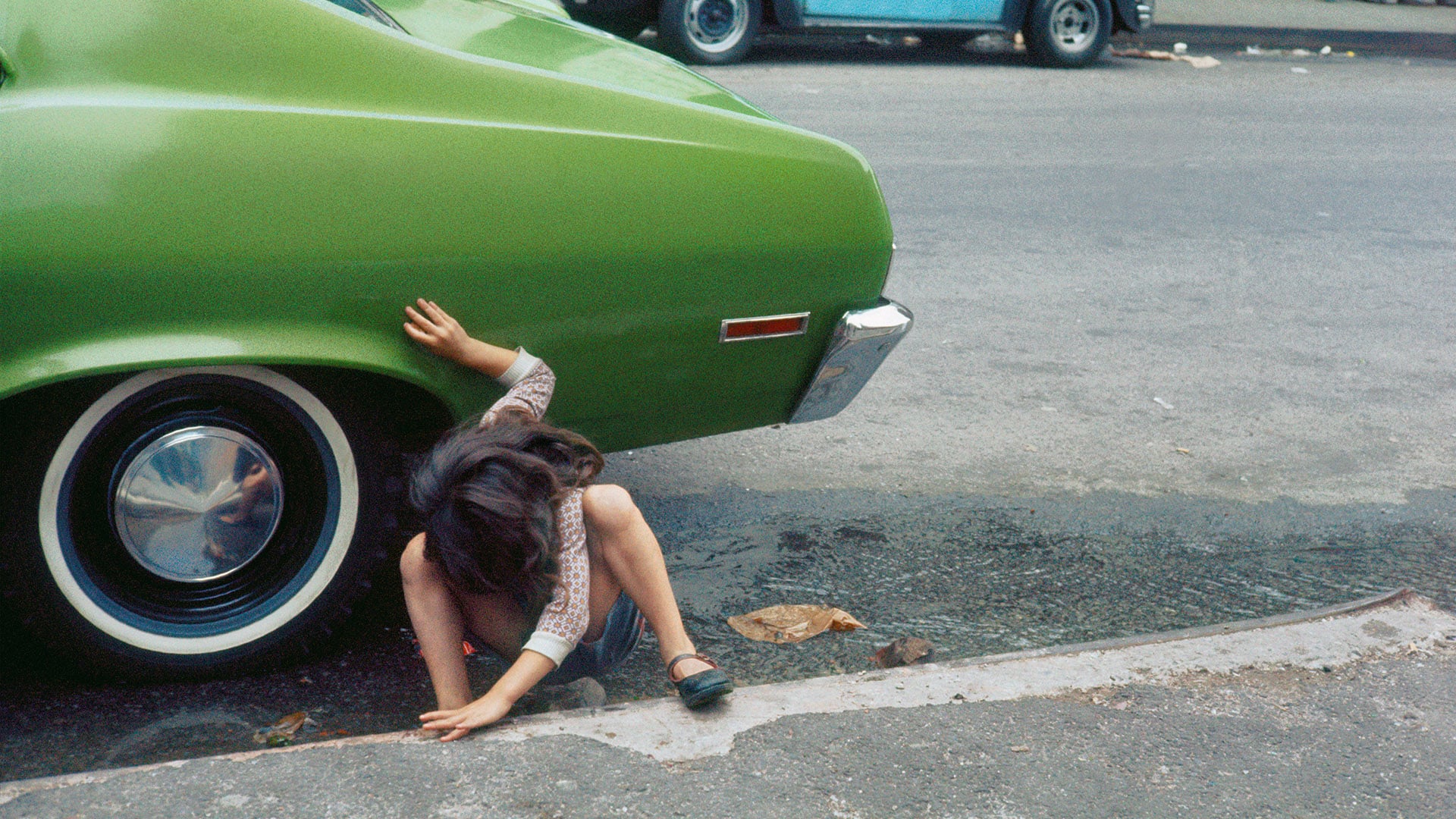
Helen Levitt, New York, 1980. Private collection. Film Documents LLC/Courtesy Thomas Zander Gallery, Cologne.
” This is one of Helen Levitt‘s last and at the same time strongest photograph. “Spider-Girl” shows aspects of both her late color work as well as her early black and white photographs from the 1930s and 40s. It was in the 1950s and then again 20 years later when Levitt following a career in film turned yet again to photography and started working in color. The technical parameters of shooting and the urban landscape of New York had changed: Children, once her favorite topic, had disappeared from the streets and been replaced by cars and elderly people on sidewalks, who now dominated her photographs. When children appeared in the pictures they were crammed into tight spaces. Here the girl is squeezes in between a car and the sidewalk. Due to the long exposure time of color film Levitt started to compose her pictures differently. They are less dynamic, yet working with contrasts in color permitted her to create new layers of meaning and spatial situations. The girl’s pose with an obscured face and solely typified by her twisted extremities is echoing Levitt’s surrealistic sensibility of the 1930s and 40s. In her early black and white photographs Levitt frequently showed passersby in strange poses that gave them an alienated and uncanny appearance, breaking with cultural norms regarding depictions of the body. These “grotesque” and subversive representations found their way into Levitt’s works not only through Surrealism, but also through silent and slapstick cinema. “

© Helen Levitt
” The silent film influenced Helen Levitt’s way of representing dynamic bodies and expressive gestures decisively. The artist had been an enthusiastic moviegoer since her youth, enjoying the likes of Buster Keaton or Laurel and Hardy, admiring Charlie Chaplin most of all. Their forms of expression were discussed widely in artist circles of the 1930s and 1940s like the Film and Photo League. Whereas Chaplin and Keaton had relied on exalted gestures, the sound film, gaining popularity in the mid-1930s, entailed a change in acting. Gestures became increasingly restrained and were subordinated to the spoken word. Regarded critically this development again made the silent film an important point of reference for photographers and filmmakers (for example Jean Vigo and Jean Cocteau) who treasured its wider range of visual expression in its expressive bodily representations. Levitt reformulates Charlie Chaplin’s typical way of interacting with objects. Chaplin frequently modified the original function of objects for the sake of the joke. Levitt employed this approach in the picture of a woman, who bends down into a stroller, which in turn appears to swallow her upper body. Like in Chaplin films the objects determine the protagonist’s gestures. The form of the flower in the photograph of the grim looking girl repeats and emphasize her expressively outspread fingers. “

© Helen Levitt
” It is often said that Helen Levitt worked with an angle finder–a device which enabled her to photograph people without their knowledge. In my opinion this notion is over-emphasized. For example in the photographs of two smoking boys or a group of four men, the subjects seem unaware of the photographer. Comparing these pictures with the negatives, and seeing other, unpublished variants, it becomes apparent that the people are interacting with Levitt, at times looking or laughing into the camera. In the former photograph Levitt obscured this aspect by cropping a third person, who looked directly into the camera thus revealing the interaction as such. Levitt didn’t stage the people but very often the subjects in the pictures performed and posed being fully aware of the photographer. “

” By 1935 at the latest, Levitt came in touch with the Surrealist movement through Henri Cartier-Bresson’s work. Photographers discovered the urban spaces, where they found paradoxical, enigmatic and humorous elements in their everyday surroundings, when seemingly aimlessly walking the streets. Levitts photographs are based on an ethnographical approach: She rendered children in Halloween costumes and masks as eerie actors of a magic ritual. It strikes one as no mere coincidence that masks were central objects in the context of primitive art, which at the time could regularly be seen in exhibitions, for example in the Museum of Modern Art in New York. Also the French magazine Documents, founded by the Surrealist group around Georges Bataille, is a key influence for the surrealist field-research. Documents shows ethnographic documentation of masks from the British museum or cover designs of the famous serial novel Fantômas, thus combining examples from high and pop culture. “
Interview by Jean-Baptiste Gauvin
Helen Levitt, Observatrice des rues New-Yorkaises
Espace Van Gogh, July 1–September 22, 10am–7:30pm
Arles


